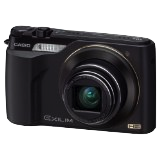 Updated my camera today. The Casio Exilim EX-FH100 is a newer version of the EX-FC100. It does everything the older one did and then adds a few more features. Oh, and it is black. Somehow, that makes it better just for that reason.
Updated my camera today. The Casio Exilim EX-FH100 is a newer version of the EX-FC100. It does everything the older one did and then adds a few more features. Oh, and it is black. Somehow, that makes it better just for that reason.
So, what is different? First off, the lens can now do a 10x optical zoom compared to a 5x on the FC100. This is a real boon giving huge flexibility from a small camera. the wide angle setting is described as 24mm. I guess that makes it equivalent to a 24mm lens on a SLR camera. Images are fine at both extents.
With such a large zoom, you may worry about shake and blurry images. The inbuilt anti-shake seems to do a good job though. If that alone won’t fix up your pictures there are a couple of trick modes to help. For low light, there is a mode that uses the accelerometer to decide whether or not you are using a tripod. If it thinks the camera is still enough, it takes a longer exposure at a slower film speed for sharper results. If it thinks the camera is moving – hand held – then it takes several exposures and combines then to minimize blur.
The ability to take multiple images and combine the is used in several other modes as well.
The High Speed Best Shot mode takes aseries of images while the shutter is held down and then examines each one for the best faces. That is, smiling faces that are not blinking. This works really well in the few tests i have tried so far.
High Dynamic Range pictures are made possible in another mode that takes several images at different settings and combines them to allow you to see detail in shadows while retaining information in bright areas. While the effect looks a little unnatural on the screen, it more accurately reflects what you see. This too works very well.
I bought the original camera to allow high speed video at 210 frames per second for analysing micromouse movement. This feature is slightly enhanced by increasing the frame rate a little for each mode. thus, the new camera does 240 frames per secod rather than 210.
Image quality is supposed to be better as well. This afternoon, I took two pictures, one using the Casio and another using a Canon EOS 400D. Both set at wide angle, both on the default automatic settings. Both cameras have similar resolution Examining the Casio image at 1:1 size on the computer, showed the picture to look grainy and slightly rippled. I was quite dissapointed. Then I viewed the Canon image, also at 1:1. that was a bit of a surprise. The Canon image had very little visible noise but also seemed to be a lot softer in focus, lacking some detail. Viewed side by side so that the whole picture was visible, the Canon image seemed to lack clarity and had a poorer colour balance. On the other hand, fine details on a wall map, while being less sharp, appeared less distorted on the Canon. More test are needed but I am not at all unhappy with the overall image quality on the Casio. When a visitor to the office was asked which image came from the Casio and which from the Canon, he got it the wrongway round and was quite surprised to find he was wrong.
If you want one of these, click the image below to have a look on Amazon and get yourself one for Christmas.
